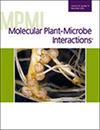Sarah Lipps, Martin Bohn, Jessica Rutkoski, Carolyn Butts-Wilmsmeyer, Santiago Mideros, Tiffany Jamann
求助PDF
{"title":"禾谷镰刀菌感染玉米和小麦的比较研究:抗性机制的相似性与未来发展方向。","authors":"Sarah Lipps, Martin Bohn, Jessica Rutkoski, Carolyn Butts-Wilmsmeyer, Santiago Mideros, Tiffany Jamann","doi":"10.1094/MPMI-08-24-0083-FI","DOIUrl":null,"url":null,"abstract":"<p><p><i>Fusarium graminearum</i> is one of the most important plant-pathogenic fungi that causes disease on wheat and maize, as it decreases yield in both crops and produces mycotoxins that pose a risk to human and animal health. Resistance to Fusarium head blight (FHB) in wheat is well studied and documented. However, resistance to Gibberella ear rot (GER) in maize is less understood, despite several similarities to FHB. In this review, we synthesize existing literature on the colonization strategies, toxin accumulation, genetic architecture, and potential mechanisms of resistance to GER in maize and compare it with what is known regarding FHB in wheat. There are several similarities in the infection and colonization strategies of <i>F. graminearum</i> in maize and wheat. We describe multiple types of GER resistance in maize and identify distinct genetic regions for each resistance type. We discuss the potential of phenylpropanoids for biochemical resistance to <i>F. graminearum.</i> Phenylpropanoids are well characterized, and there are many similarities in their functional roles for resistance between wheat and maize. These insights can be utilized to improve maize germplasm for GER resistance and are also useful for FHB resistance breeding and management. [Formula: see text] Copyright © 2025 The Author(s). This is an open access article distributed under the CC BY-NC-ND 4.0 International license.</p>","PeriodicalId":19009,"journal":{"name":"Molecular Plant-microbe Interactions","volume":" ","pages":"142-159"},"PeriodicalIF":3.4000,"publicationDate":"2025-03-01","publicationTypes":"Journal Article","fieldsOfStudy":null,"isOpenAccess":false,"openAccessPdf":"","citationCount":"0","resultStr":"{\"title\":\"Comparative Review of <i>Fusarium graminearum</i> Infection in Maize and Wheat: Similarities in Resistance Mechanisms and Future Directions.\",\"authors\":\"Sarah Lipps, Martin Bohn, Jessica Rutkoski, Carolyn Butts-Wilmsmeyer, Santiago Mideros, Tiffany Jamann\",\"doi\":\"10.1094/MPMI-08-24-0083-FI\",\"DOIUrl\":null,\"url\":null,\"abstract\":\"<p><p><i>Fusarium graminearum</i> is one of the most important plant-pathogenic fungi that causes disease on wheat and maize, as it decreases yield in both crops and produces mycotoxins that pose a risk to human and animal health. Resistance to Fusarium head blight (FHB) in wheat is well studied and documented. However, resistance to Gibberella ear rot (GER) in maize is less understood, despite several similarities to FHB. In this review, we synthesize existing literature on the colonization strategies, toxin accumulation, genetic architecture, and potential mechanisms of resistance to GER in maize and compare it with what is known regarding FHB in wheat. There are several similarities in the infection and colonization strategies of <i>F. graminearum</i> in maize and wheat. We describe multiple types of GER resistance in maize and identify distinct genetic regions for each resistance type. We discuss the potential of phenylpropanoids for biochemical resistance to <i>F. graminearum.</i> Phenylpropanoids are well characterized, and there are many similarities in their functional roles for resistance between wheat and maize. These insights can be utilized to improve maize germplasm for GER resistance and are also useful for FHB resistance breeding and management. [Formula: see text] Copyright © 2025 The Author(s). This is an open access article distributed under the CC BY-NC-ND 4.0 International license.</p>\",\"PeriodicalId\":19009,\"journal\":{\"name\":\"Molecular Plant-microbe Interactions\",\"volume\":\" \",\"pages\":\"142-159\"},\"PeriodicalIF\":3.4000,\"publicationDate\":\"2025-03-01\",\"publicationTypes\":\"Journal Article\",\"fieldsOfStudy\":null,\"isOpenAccess\":false,\"openAccessPdf\":\"\",\"citationCount\":\"0\",\"resultStr\":null,\"platform\":\"Semanticscholar\",\"paperid\":null,\"PeriodicalName\":\"Molecular Plant-microbe Interactions\",\"FirstCategoryId\":\"99\",\"ListUrlMain\":\"https://doi.org/10.1094/MPMI-08-24-0083-FI\",\"RegionNum\":3,\"RegionCategory\":\"生物学\",\"ArticlePicture\":[],\"TitleCN\":null,\"AbstractTextCN\":null,\"PMCID\":null,\"EPubDate\":\"2025/4/3 0:00:00\",\"PubModel\":\"Epub\",\"JCR\":\"Q2\",\"JCRName\":\"BIOCHEMISTRY & MOLECULAR BIOLOGY\",\"Score\":null,\"Total\":0}","platform":"Semanticscholar","paperid":null,"PeriodicalName":"Molecular Plant-microbe Interactions","FirstCategoryId":"99","ListUrlMain":"https://doi.org/10.1094/MPMI-08-24-0083-FI","RegionNum":3,"RegionCategory":"生物学","ArticlePicture":[],"TitleCN":null,"AbstractTextCN":null,"PMCID":null,"EPubDate":"2025/4/3 0:00:00","PubModel":"Epub","JCR":"Q2","JCRName":"BIOCHEMISTRY & MOLECULAR BIOLOGY","Score":null,"Total":0}
引用次数: 0
引用
批量引用

 求助内容:
求助内容: 应助结果提醒方式:
应助结果提醒方式:


